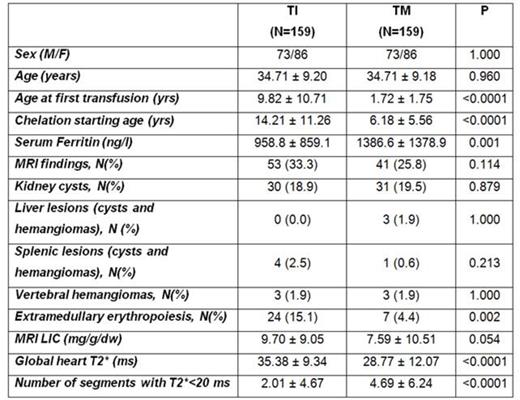Abstract

BACKGROUND: The prevalence and the clinical relevance of several extracardiac findings (EF) at Magnetic Resonance Imaging (MRI) have been recently estimated in cohorts of non thalassaemic patients.
AIM: In this study we sought to determine the prevalence of EF potentially related to anaemia and ipoxia in age- and sex- matched populations with thalassaemia major (TM) and Thalassaemia Intermedia (TI).
METHODS: We retrospectively considered 159 TM patients regularly transfused (73 F; 34±9.20 years) and 159 TI patients (73 F; 34±9.18 years) consecutively enrolled in the Myocardial Iron in Thalassemia (MIOT) Network to quantify cardiac and liver iron by T2* technique. Patients with TI were further subdivided in non transfusion dependent (NTD-TI) and transfusion dependent (TD-TI). All MRI images were used to assess the presence or absence of Extramedullary Hematopoiesis (EMH), kidney, splenic and liver cysts, and vertebral hemangiomas.
RESULTS: Overall, EF were detected in 33% and 26% of patients with TI and TM, respectively. Table 1 shows the comparison of MRI data between TM and TI patients. Both groups of patients had elevated but comparable prevalence of kidney, splenic and liver cysts and vertebral haemangiomas. TI patients were found to have significant higher EMH as compared to TM. The prevalence of total EF increased with advancing age and renal cysts were found in the 28.6% of the cohort aged 45-55 years. Patients with renal cysts had comparable serum creatinin level with respect to those without. Within the population of TI-TD it was observed the highest prevalence of patients with renal cysts, splenic cyst and vertebral haemangioma (26%, 3% and 3%, respectively).
Thalassemic patients had a was significant higher prevalence of renal cysts than the general population (19.2 vs 7.8%; P<0.0001).
CONCLUSIONS: EF are well-recognized features in patients undergoing MRI, being hepatic cysts or hemangiomas and renal cyst the most frequently observed. Our data on hemangiomas and renal cysts, particularly among patients with TI-TD, indicate a significant higher prevalence of EF compared to the general population. These data seem to suggest the role of the inappropriate activation of the Hypoxia-Inducible Factor (HIF) system linked to the chronic hypoxia as observed in the Chuvash polycythemia or in the the von Hippel-Lindau (VHL) syndrome. Furthermore, HIF in general population has been directly involved in the development and/or progression of clear cell renal cancer also described among thalassemic patients.
Pepe:Chiesi: Speakers Bureau; ApoPharma Inc: Speakers Bureau; Novartis: Speakers Bureau.
Author notes
Asterisk with author names denotes non-ASH members.

This icon denotes a clinically relevant abstract


